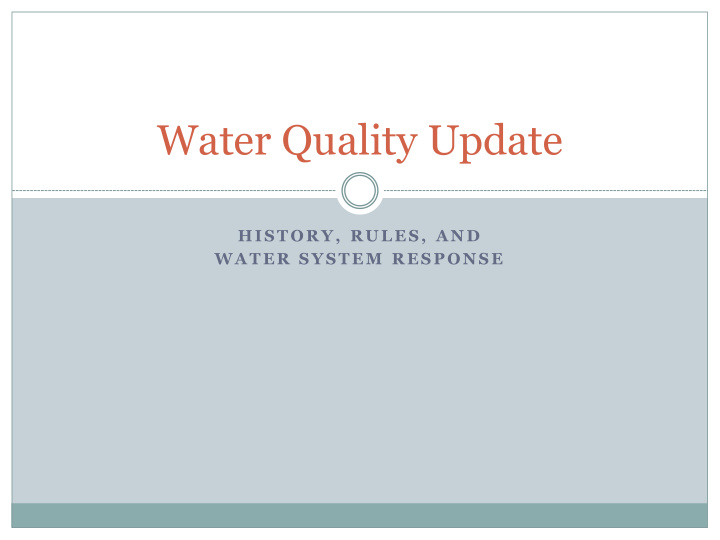



Water Quality Update HIST ORY, RU LES, A ND WAT ER SYST EM RESPONSE
Health Effects of Lead Lead serves no useful purpose in the human body, and its presence can lead to toxic effects. In children, lead exposure can result in: Behavior problems Learning disabilities Problems with physical development Adults exposed to lead may experience: Neurological problems Kidney problems Hypertension Reproductive issues
How Does Lead Get Into Drinking Water? When pipes or fixtures containing lead corrode, such as when water has high acidity or low mineral content, lead can enter the drinking water. Most common problems: Brass or chrome-plated brass faucets Pipes and fixtures with lead solder Houses built before 1986 are more likely to have lead pipes, fixtures, and solder.
Regulation History January 2000 2017 LCR Minor June 1991 LCR Long Term Revisions Original LCR Revisions October 2007 promulgated promulgated June 1986 (projected) LCR Short Term SDWA Amendments Revisions August 1996 Signed promulgated SDWA Amendments signed August 1988 January 2011 Deadline to meet Reduction of Lead in January 2014 lead ban Drinking Water Act August 1998 Reduction of Lead in 1974 signed Deadline to meet Drinking Water Act Safe Drinking new “lead free” takes effect December 2013 Water Act definition Community Fire Safety Act signed
Flint, Michigan Lead Crisis Water Source Change From Lake Huron to Flint River Surface water source – constant environmental impact Flint River water contains a concentration of chloride ion that is 9 times greater than Lake Huron Water Treatment No corrosion control treatment was added to the water from the Flint River Infrastructure About half of the service lines leading to the homes in Flint were constructed of lead Regulation The Michigan Department of Environmental Quality incorrectly interpreted the Lead and Copper Rule MDEQ and MDHHS waited to involve EPA and resisted returning to the Detroit water system Management The decision to change water supply was made to save $5 M Water quality complaints began soon after the water supply change
Differences Between Flint and Tallahassee Tallahassee Water Source Floridan Aquifer Groundwater source, not subject to runoff or surface water intrusion Naturally non-corrosive pH of 7.2-7.6 Consistent temperature of 68-72 degrees Fahrenheit Average hardness of 156 mg/l Average chlorides of 6 ppm (secondary standard = 250 ppm) Water Treatment Source, system, and home sampling results indicated that treatment for corrosion control is not necessary.
City of Tallahassee Corrosivity Analysis Corrosion / Scale LSI Forming Potential -4 Severe Corrosion -3 Moderate Corrosion -2 Moderate Corrosion -1 Mild Corrosion -0.5 None-Mild Corrosion 0 Near Balanced 0.5 Faint Scale 1 Mild Scale 2 Mild-Moderate Scale 3 Moderate Scale 4 Severe Scale
Differences Between Flint and Tallahassee Infrastructure In advance of the LCR in 1991, the City identified lead piping and lead home service lines and removed them. Regulation Required monitoring – triennial tap sampling at 50 homes/businesses Compliance inspections annually and Sanitary Surveys every 3-5 years Water quality monitoring and reporting Most recent lead sampling indicated that lead is not an issue in the COT water system Management Budgeting – supported by the Water Master Plan (nearly $50 M approved) Aging infrastructure replacement program Master Plan (downtown area pipe replacement) Galvanized and older pipe replacement program Government “in the sunshine” AWWA “Best Tasting Drinking Water”
Setting the Standard for Excellence 2014 FDEP Sanitary Survey “ Again this year, as in the last several years, notice was taken as to the sense of ownership and pride among the operating staff… ” Voted “Best Tasting Drinking Water” by 2008 – Regional and State-wide Winner 2015 – Regional and State-wide Winner 2016 – Regional and State-wide Winner
Recommend
More recommend